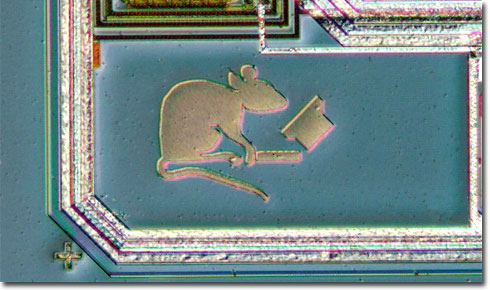Pac Rat (Programmable Analog Circuit)
|
A pack rat is the logo for the programmable analog circuit design team (PAC) at Lattice Semiconductor Corporation, who is responsible for designing and producing the ispPAC30, a dynamically reconfigurable analog device. The chip contains four programmable gain instrumentation amplifiers, two multiplying digital-to-analog converters, and two configurable output amplifiers with rail-to-rail outputs. One of the design engineers who produced the chip, Greg Rohde, has provided a copy of the chip (illustrated above) and information about the artwork. There are two additional doodles on the ispPAC30 integrated circuit. One is a wolf silhouette, while the other is a can of worms symbolizing the problems encountered during the chip's design. Woodrats in the genus Neotoma are commonly called pack rats or trade rats. Living up to their common names, Neotoma species collect various objects and bits of material and use them to construct and decorate their nests. Pack rats are particularly fond of small, bright-colored, shiny objects and reportedly have even expropriated valuable items such as earrings, precious gems, and coins. Ranging widely throughout the North American deserts, pack rats reach northwards into Canada and south into Central America. There are 22 described species of woodrats in the family Cricetidae of the order Rodentia. Habitat for pack rats varies from the desert lowlands to the pine-juniper forests on the rocky mountainsides at an elevation of approximately 8,000 feet. The famous nests (known also as middens) of Neotoma are often built of branches, twigs, and other plant debris, and may be up to four feet in diameter. Perched in a tree, along the base of a rocky ledge, or even in the eaves of an abandoned cabin, woodrats can become a serious nuisance when living near humans, by stealing their "treasures" as well as damaging electrical wiring, entering attics and basements, and even invading car engine compartments and trunks. The nests of pack rats are often built on sites used by several generations of the rodents. |
© 1995-2025 by Michael W. Davidson and The Florida State University. All Rights Reserved. No images, graphics, software, scripts, or applets may be reproduced or used in any manner without permission from the copyright holders. Use of this website means you agree to all of the Legal Terms and Conditions set forth by the owners.
This website is maintained by our
|
